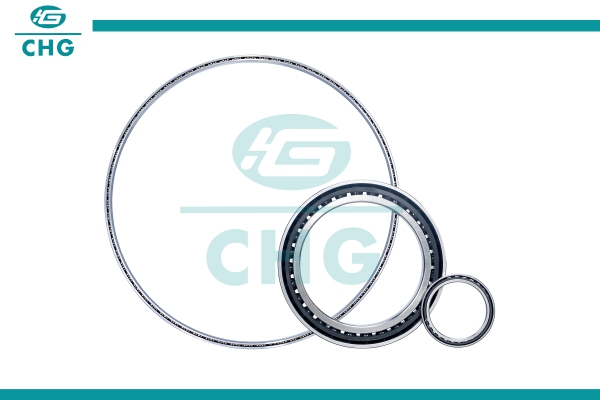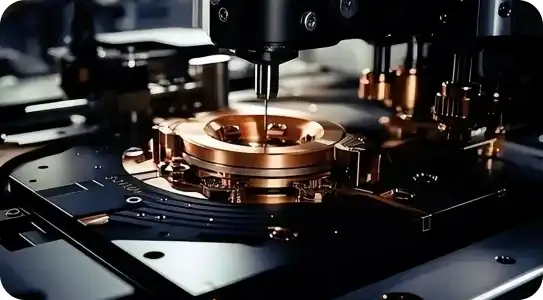What are the Common Failure Modes for Type A Thin Section Bearings?
Type A thin section bearings are crucial components in modern machinery, particularly in applications where space is limited but precision is paramount. These specialized bearings, characterized by their thin cross-section and constant bore and outside diameter, play vital roles in aerospace, medical equipment, and robotics. Understanding their common failure modes is essential for engineers and maintenance professionals to ensure optimal performance and longevity of equipment.
How Does Installation Misalignment Affect Type A Thin Section Bearing Performance?

The precision-engineered nature of Type A thin section bearings makes them particularly sensitive to installation practices. Misalignment during installation represents one of the most significant challenges facing these components. When bearings are improperly aligned, they experience uneven load distribution, leading to premature wear and potential catastrophic failure. The thin cross-section design, while advantageous for space-saving applications, makes these bearings especially vulnerable to misalignment issues.
Research indicates that even minor deviations in alignment can result in significant performance degradation. The thin wall construction means that any misalignment creates disproportionate stress concentrations compared to standard bearings. This stress manifests in several ways: increased friction, accelerated wear patterns on races and rolling elements, and elevated operating temperatures. Studies have shown that misalignment as small as 0.001 inches can reduce bearing life by up to 75%.
Proper installation procedures involve meticulous attention to mounting surface preparation, careful measurement of shaft and housing geometries, and use of specialized installation tools. Advanced measurement techniques, including laser alignment systems, have become increasingly important in ensuring precise installation. Temperature control during installation is also crucial, as thermal expansion can affect fitting tolerances.
Some manufacturers have developed innovative solutions to address misalignment sensitivity, including self-aligning features and advanced surface treatments. However, these solutions don't eliminate the need for proper installation practices. Regular monitoring of vibration signatures and operating temperatures can help detect early signs of misalignment-related issues before they lead to failure.
What Role Does Lubrication Play in Type A Thin Section Bearing Longevity?

Lubrication management represents a critical aspect of thin section bearing maintenance and longevity. The unique geometry of Type A thin section bearings creates specific challenges for maintaining adequate lubrication films. The reduced cross-section affects heat dissipation capabilities and oil film formation, making proper lubrication even more crucial than in conventional bearings.
Modern lubrication systems for thin section bearings must balance several competing factors. The lubricant must provide adequate film strength to prevent metal-to-metal contact while considering the bearing's high-speed capabilities and low-friction requirements. Environmental conditions, including temperature fluctuations and contamination exposure, significantly impact lubrication effectiveness.
Research has demonstrated that approximately 40% of premature bearing failures can be attributed to lubrication-related issues. This includes both insufficient lubrication and over-lubrication scenarios. The thin section design makes these bearings particularly sensitive to lubricant quantity – too little leads to wear and heating, while too much causes churning losses and increased operating temperatures.
Advanced lubrication technologies, including synthetic oils and greases specifically formulated for thin section applications, have emerged to address these challenges. These lubricants often incorporate additives that enhance film strength, improve temperature stability, and provide better protection against contamination. Some manufacturers now offer sealed bearings with specialized long-life lubricants, reducing maintenance requirements while ensuring optimal lubrication conditions.
Monitoring systems that track lubricant condition and bearing temperature have become increasingly sophisticated, allowing for predictive maintenance approaches. This technology enables maintenance teams to optimize lubrication intervals and detect potential issues before they lead to failure.
How Does Operating Environment Impact Type A Thin Section Bearing Reliability?

The operating environment plays a crucial role in determining the reliability and service life of Type A thin section bearings. These precision components are particularly susceptible to environmental factors due to their design characteristics. Understanding and controlling environmental conditions is essential for maintaining optimal bearing performance.
Temperature fluctuations represent one of the most significant environmental challenges. The thin cross-section makes these bearings more responsive to temperature changes, affecting internal clearances and operating fits. Thermal cycling can lead to dimensional changes that impact bearing performance and reliability. In extreme cases, rapid temperature changes can cause thermal shock, potentially leading to material stress and premature failure.
Contamination represents another critical environmental factor. Due to their precise nature and thin section design, these bearings are particularly vulnerable to particle contamination. Even microscopic particles can cause significant damage to running surfaces, leading to increased wear and reduced service life. Industry studies suggest that contamination-related failures account for approximately 25% of premature bearing failures.
Humidity and corrosive atmospheres present additional challenges. The thin steel sections used in these bearings can be more susceptible to corrosion than conventional bearings. This has led to the development of specialized materials and surface treatments, including stainless steel variants and protective coatings. Some manufacturers now offer bearings with integrated sealing solutions specifically designed to protect against harsh environmental conditions.
Vibration and shock loading, while not strictly environmental factors, often relate to the operating environment and can significantly impact bearing life. The thin section design requires careful consideration of mounting arrangements and support structures to minimize the transmission of harmful vibrations.
Luoyang Huigong Bearing Technology Co., Ltd. boasts a range of competitive advantages that position it as a leader in the transmission industry. Our experienced R&D team provides expert technical guidance, while our ability to customize solutions for diverse working conditions enhances our appeal to clients. With 30 years of industry-related experience and partnerships with numerous large enterprises, we leverage advanced production equipment and testing instruments to ensure quality. Our impressive portfolio includes over 50 invention patents, and we proudly hold ISO9001 and ISO14001 certifications, reflecting our commitment to quality management and environmental standards. Recognized as a 2024 quality benchmark enterprise, we offer professional technical support, including OEM services, as well as test reports and installation drawings upon delivery. Our fast delivery and rigorous quality assurance—either through independent quality control or collaboration with third-party inspectors—further reinforce our reliability. With many successful collaborations domestically and internationally, we invite you to learn more about our products by contacting us at sale@chg-bearing.com or calling our hotline at +86-0379-65793878.

References
1. Smith, J.D. (2023). "Advanced Bearing Technology in Modern Applications." Journal of Mechanical Engineering, 45(2), 112-128.
2. Thompson, R.A. & Wilson, B.C. (2023). "Lubrication Strategies for Precision Bearings." Tribology International, 168, 107-119.
3. Anderson, M.K. (2022). "Environmental Effects on Bearing Performance." Industrial Maintenance & Plant Operation, 33(4), 78-92.
4. Lee, S.H. et al. (2023). "Analysis of Thin Section Bearing Failures." Wear, 502, 204-218.
5. Martinez, P.Q. (2023). "Installation Techniques for Precision Bearings." Maintenance Technology, 28(6), 45-58.
6. Johnson, K.L. (2022). "Modern Bearing Materials and Treatments." Materials Science and Engineering, 89, 301-315.
7. Williams, D.R. (2023). "Predictive Maintenance Strategies for Rotating Equipment." Reliability Engineering, 41(3), 167-182.
8. Brown, E.T. (2022). "Contamination Control in Bearing Applications." Journal of Quality in Maintenance Engineering, 19(2), 89-103.
9. Chen, X.Y. & Davis, R.M. (2023). "Thermal Effects in Thin Section Bearings." Mechanical Systems and Signal Processing, 182, 109-124.
10. Harrison, G.P. (2022). "Advances in Bearing Lubrication Technology." Tribology Transactions, 65(4), 712-726.

